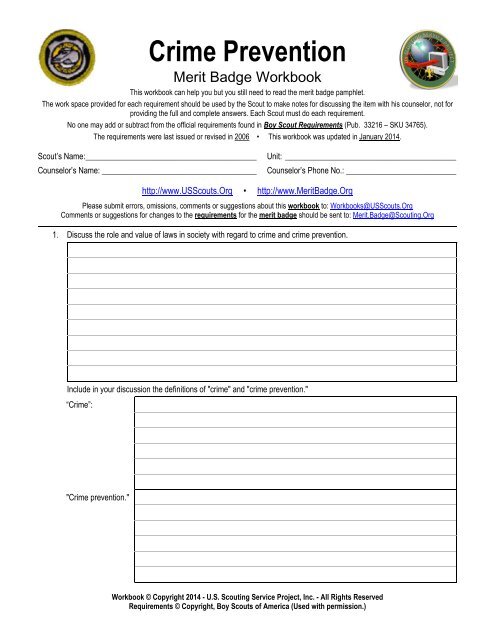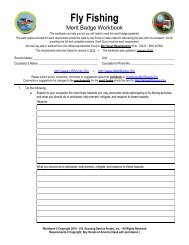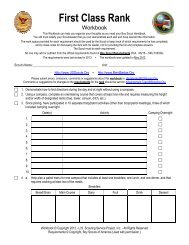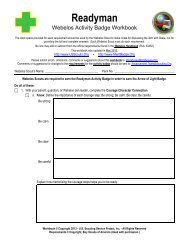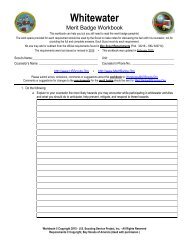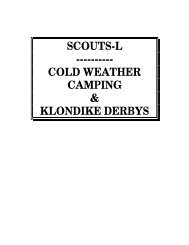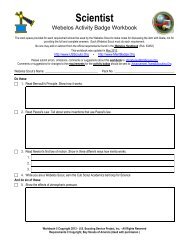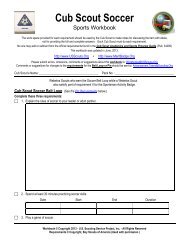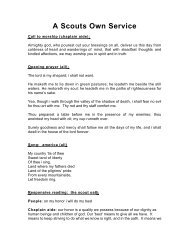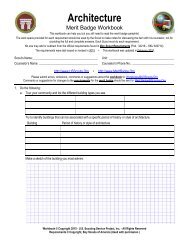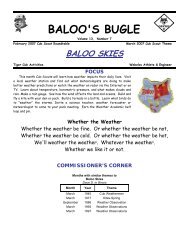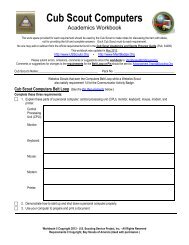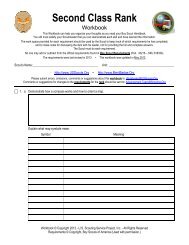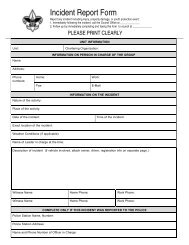Crime Prevention - Merit Badge - US Scouting Service Project
Crime Prevention - Merit Badge - US Scouting Service Project
Crime Prevention - Merit Badge - US Scouting Service Project
You also want an ePaper? Increase the reach of your titles
YUMPU automatically turns print PDFs into web optimized ePapers that Google loves.
<strong>Crime</strong> <strong>Prevention</strong><br />
<strong>Merit</strong> <strong>Badge</strong> Workbook<br />
This workbook can help you but you still need to read the merit badge pamphlet.<br />
The work space provided for each requirement should be used by the Scout to make notes for discussing the item with his counselor, not for<br />
providing the full and complete answers. Each Scout must do each requirement.<br />
No one may add or subtract from the official requirements found in Boy Scout Requirements (Pub. 33216 – SKU 34765).<br />
The requirements were last issued or revised in 2006 • This workbook was updated in January 2014.<br />
Scout’s Name:__________________________________________<br />
Counselor’s Name: ______________________________________<br />
Unit: __________________________________________<br />
Counselor’s Phone No.: ___________________________<br />
http://www.<strong>US</strong>Scouts.Org • http://www.<strong>Merit</strong><strong>Badge</strong>.Org<br />
Please submit errors, omissions, comments or suggestions about this workbook to: Workbooks@<strong>US</strong>Scouts.Org<br />
Comments or suggestions for changes to the requirements for the merit badge should be sent to: <strong>Merit</strong>.<strong>Badge</strong>@<strong>Scouting</strong>.Org<br />
______________________________________________________________________________________________________________________________________________<br />
1. Discuss the role and value of laws in society with regard to crime and crime prevention.<br />
Include in your discussion the definitions of "crime" and "crime prevention."<br />
“<strong>Crime</strong>”:<br />
"<strong>Crime</strong> prevention."<br />
Workbook © Copyright 2014 - U.S. <strong>Scouting</strong> <strong>Service</strong> <strong>Project</strong>, Inc. - All Rights Reserved<br />
Requirements © Copyright, Boy Scouts of America (Used with permission.)
<strong>Crime</strong> <strong>Prevention</strong><br />
Scout's Name: ________________________<br />
2. Prepare a notebook of newspaper and other clippings that addresses crime and crime prevention efforts in your<br />
community.<br />
3. Discuss the following with your counselor:<br />
a. The role of citizens, including youth, in crime prevention<br />
b. Gangs and their impact on the community<br />
c. When and how to report a crime<br />
4. After doing EACH of the following, discuss with your counselor what you have learned.<br />
a. Inspect your neighborhood for opportunities that may lead to crime.<br />
<strong>Crime</strong> <strong>Prevention</strong> - <strong>Merit</strong> <strong>Badge</strong> Workbook Page. 2 of 9
<strong>Crime</strong> <strong>Prevention</strong><br />
Scout's Name: ________________________<br />
Learn how to do a crime prevention survey.<br />
b. Using the checklist in this (the merit badge) pamphlet, conduct a security survey of your home and discuss the<br />
results with your family. (A copy of the Home Safety Checklist can be found at the end of this workbook.)<br />
5. Teach your family or patrol members how to protect themselves from crime at home.<br />
6. Help raise awareness about one school safety issue facing students by doing ONE of the following:<br />
a. Create a poster for display on a school bulletin board.<br />
b. With permission from school officials, create a page long public service announcement that could be read over<br />
the public address system at school or posted on the school's Web site.<br />
c.<br />
Make a presentation to a group such as a Cub Scout den that addresses the issue.<br />
<strong>Crime</strong> <strong>Prevention</strong> - <strong>Merit</strong> <strong>Badge</strong> Workbook Page. 3 of 9
<strong>Crime</strong> <strong>Prevention</strong><br />
Scout's Name: ________________________<br />
7. Do ONE of the following:<br />
a. Assist in the planning and organization of a crime prevention program in your community such as Neighborhood<br />
Watch, Community Watch, or <strong>Crime</strong> Stoppers. Explain how this program can benefit your neighborhood.<br />
b.<br />
With your parent's and counselor's approval, visit a jail or detention facility or a criminal court hearing.<br />
Discuss your experience with your counselor.<br />
8. Discuss the following with your counselor:<br />
a. How drug abuse awareness programs, such as "Drugs: A Deadly Game," help prevent crime<br />
b. Why alcohol, tobacco, and marijuana are sometimes called "gateway drugs" and how "gateway drugs" can lead<br />
to the use of other drugs<br />
<strong>Crime</strong> <strong>Prevention</strong> - <strong>Merit</strong> <strong>Badge</strong> Workbook Page. 4 of 9
<strong>Crime</strong> <strong>Prevention</strong><br />
Scout's Name: ________________________<br />
c. Three resources in your city where a person with a drug problem or drug-related problem can go for help<br />
d. How the illegal sale and use of drugs lead to other crimes<br />
e. How to recognize child abuse<br />
f. The three R's of Youth Protection<br />
9. Discuss the following with your counselor:<br />
a. The role of a sheriff's or police department in crime prevention.<br />
<strong>Crime</strong> <strong>Prevention</strong> - <strong>Merit</strong> <strong>Badge</strong> Workbook Page. 5 of 9
<strong>Crime</strong> <strong>Prevention</strong><br />
Scout's Name: ________________________<br />
b. The purpose and operation of agencies in your community that help law enforcement personnel prevent crime,<br />
and how those agencies function during emergency situations.<br />
c. Explain the role private security plays in crime prevention.<br />
d. Choose a career in the crime prevention or security industry that interests you.<br />
Career<br />
Describe the level of education required and responsibilities of a person in that position.<br />
Education:<br />
Responsibilities:<br />
Tell why this position interests you.<br />
Requirement resources can be found here:<br />
http://www.meritbadge.org/wiki/index.php/<strong>Crime</strong> <strong>Prevention</strong>#Requirement resources<br />
<strong>Crime</strong> <strong>Prevention</strong> - <strong>Merit</strong> <strong>Badge</strong> Workbook Page. 6 of 9
Crim eP reventionM erit<strong>Badge</strong>S am pleHom eS ecurity Checklist<br />
Scout's Name: ________________________<br />
Here are some things to consider with your parent or guardian and counselor. See your <strong>Crime</strong> <strong>Prevention</strong> <strong>Merit</strong> <strong>Badge</strong> Pamphlet<br />
for explanations about each item on the checklist.<br />
1. Do you keep a list of all valuable property? Is at least one copy kept outside your home?<br />
2. Do you have a list of the serial numbers of your valuable property (watches, cameras, computers, TVs, etc.)?<br />
3. Do you have descriptions/photographs of valuable property from each room in your home (and closets)?<br />
4. Do you keep excess cash and other valuables in a bank? Consider renting a safe deposit box for important papers.<br />
5. Do you plan so that you don't need to "hide" a house key under the doormat or in a similar location?<br />
6. Do your family members know what to do if they discover a burglar in your home? Don’t go in! Dial 911!<br />
7. Do family members know to leave everything undisturbed and call the sheriff or police if they discover a burglary?<br />
8. Are trees and shrubs trimmed to eliminate hiding places?<br />
9. Do you have a security closet with a solid-core door, non-removable hinges, and a deadbolt lock? For items of value.<br />
10. Do you have emergency telephone numbers listed on your phone? In most areas of the country it is 911.<br />
11.<br />
12.<br />
13.<br />
14.<br />
15.<br />
16.<br />
17.<br />
18.<br />
19.<br />
20.<br />
21.<br />
22.<br />
23.<br />
24.<br />
25.<br />
26.<br />
27.<br />
28.<br />
29.<br />
30.<br />
31.<br />
32.<br />
33.<br />
Is the outside of your home well lit? Do you have working porch lights? Is your yard well illuminated?<br />
Is your house number easily visible from the street at any hour? Police need to see your number in an emergency.<br />
Are ladders locked up and trellises and drainpipes eliminated that can be used as ladders to reach upper floor?<br />
Are your exterior doors of solid-core construction? Hollow core wood doors offer little protection from break in.<br />
Do your entry doors have wide-angle viewers? Needed so you can see out before opening the door.<br />
Are your door's locks secure from being opened if a burglar breaks out a pane of glass or a panel of lightweight wood?<br />
Do exterior doors have cylinder-type deadbolt locks with at least a one-inch throw and a beveled cylinder guard?<br />
Do doors without cylinder locks have a heavy deadbolt or similar security that can be operated only from the inside?<br />
Can all of your doors (basement, porch, sliding, French, balcony) be securely locked?<br />
Do your basement doors have locks that allow you to isolate that part of your home?<br />
Are all of your locks in good repair?<br />
Are the door strike-plates installed with three-inch screws? Three-inch screws will reach the stud inside the wall.<br />
Do you know everyone who has a key to your home? Did you change the locks when you moved in?<br />
Do all out-swinging doors in your home have non-removable pins?<br />
Do sliding doors have a lock that locks both the door panels together or locks the active side to the frame?<br />
Is the garage door secured with a padlock, hasp, or other good lock? Even doors with electric openers need locks.<br />
Do you lock you garage door at night?<br />
Do you make sure your garage door is locked when you're away from home?<br />
Do you lock your car and take out the keys even when it is parked in your garage?<br />
Are all windows in your home equipped with key locks, or pinned?<br />
Are your window locks properly and securely mounted?<br />
Do you keep your windows locked when they are shut?<br />
Do you use locks that let you lock a window that is partly open?<br />
Workbook © Copyright 2014 - U.S. <strong>Scouting</strong> <strong>Service</strong> <strong>Project</strong>, Inc. - All Rights Reserved<br />
Requirements © Copyright, Boy Scouts of America (Used with permission.)
Crim eP reventionM erit<strong>Badge</strong>S am pleHom eS ecurity Checklist<br />
Scout's Name: ________________________<br />
34.<br />
35.<br />
36.<br />
37.<br />
38.<br />
39.<br />
40.<br />
41.<br />
42.<br />
43.<br />
44.<br />
45.<br />
Have you replaced or secured louvered windows?<br />
In high-crime areas, do you use window bars or ornamental grilles? Make sure bars or grilles don't block fire escape.<br />
Do you have secure locks on garage windows?<br />
Do you cover garage windows with curtains or shades?<br />
Are you as careful to secure basement and second-story windows as you are to secure windows on the first floor?<br />
Do you use good telephone security procedures?<br />
Never give personal information (name, age, address, etc.) to a stranger on the telephone.<br />
Never let a stranger know that you are home alone.<br />
Never let a stranger on the telephone know when you will or will not be home.<br />
When planning a trip, do you secure your telephone? Consider call forwarding or at least check messages daily.<br />
When you go on a trip, do you arrange for friends or neighbors to pick up newspapers, mail, packages, etc.?<br />
Do you arrange to make your home look lived-in while you are away? Ask friends to pick up newspapers, mail, etc. daily.<br />
Consider light timers. Ask neighbors to park in your driveway and to put out your trash cans on garbage day.<br />
Do you notify a neighbor that you'll be gone? Leave a key with a friend. Ask that your home be checked every so often.<br />
Do you notify you police or sheriff that you'll be gone?<br />
Do you store all your valuables in a secure place while you're gone, such as a safe deposit box in a bank?<br />
<strong>Crime</strong> <strong>Prevention</strong> - <strong>Merit</strong> <strong>Badge</strong> Workbook Page. 8 of 9
Important excerpts from the Guide To Advancement - 2013, No. 33088 (SKU-618673)<br />
[1.0.0.0] — Introduction<br />
The current edition of the Guide to Advancement is the official source for administering advancement in all Boy Scouts of America programs: Cub<br />
<strong>Scouting</strong>, Boy <strong>Scouting</strong>, Varsity <strong>Scouting</strong>, Venturing, and Sea Scouts. It replaces any previous BSA advancement manuals, including Advancement<br />
Committee Policies and Procedures, Advancement and Recognition Policies and Procedures, and previous editions of the Guide to Advancement.<br />
[Page 2, and 5.0.1.4] — Policy on Unauthorized Changes to Advancement Program<br />
No council, committee, district, unit, or individual has the authority to add to, or subtract from, advancement requirements. There are limited<br />
exceptions relating only to youth members with special needs. For details see section 10, “Advancement for Members With Special Needs”.<br />
[Page 2] — The “Guide to Safe <strong>Scouting</strong>” Applies<br />
Policies and procedures outlined in the Guide to Safe <strong>Scouting</strong>, No. 34416, apply to all BSA activities, including those related to advancement and<br />
Eagle Scout service projects.<br />
[7.0.3.1] — The Buddy System and Certifying Completion<br />
A youth member must not meet one-on-one with an adult. Sessions with counselors must take place where others can view the interaction, or the<br />
Scout must have a buddy: a friend, parent, guardian, brother, sister, or other relative—or better yet, another Scout working on the same badge—along<br />
with him attending the session.<br />
When the Scout meets with the counselor, he should bring any required projects. If these cannot be transported, he should present evidence, such as<br />
photographs or adult verification. His unit leader, for example, might state that a satisfactory bridge or tower has been built for the Pioneering merit<br />
badge, or that meals were prepared for Cooking. If there are questions that requirements were met, a counselor may confirm with adults involved.<br />
Once satisfied, the counselor signs the blue card using the date upon which the Scout completed the requirements, or in the case of partials, initials<br />
the individual requirements passed.<br />
Note that from time to time, it may be appropriate for a requirement that has been met for one badge to also count for another. See “Fulfilling More<br />
Than One Requirement With a Single Activity,” 4.2.3.6.<br />
[7.0.3.2] — Group Instruction<br />
It is acceptable—and sometimes desirable—for merit badges to be taught in group settings. This often occurs at camp and merit badge midways or<br />
similar events. Interactive group discussions can support learning. The method can also be attractive to “guest experts” assisting registered and<br />
approved counselors. Slide shows, skits, demonstrations, panels, and various other techniques can also be employed, but as any teacher can attest,<br />
not everyone will learn all the material.<br />
There must be attention to each individual’s projects and his fulfillment of all requirements. We must know that every Scout —actually and<br />
personally— completed them. If, for example, a requirement uses words like “show,” “demonstrate,” or “discuss,” then every Scout must do that. It is<br />
unacceptable to award badges on the basis of sitting in classrooms watching demonstrations, or remaining silent during discussions.<br />
It is sometimes reported that Scouts who have received merit badges through group instructional settings have not fulfilled all the requirements. To<br />
offer a quality merit badge program, council and district advancement committees should ensure the following are in place for all group instructional<br />
events.<br />
<br />
<br />
<br />
<br />
<br />
<strong>Merit</strong> badge counselors are known to be registered and approved.<br />
Any guest experts or guest speakers, or others assisting who are not registered and approved as merit badge counselors, do not accept the<br />
responsibilities of, or behave as, merit badge counselors, either at a group instructional event or at any other time. Their service is temporary, not<br />
ongoing.<br />
Counselors agree not to assume prerequisites have been completed without some level of evidence that the work has been done. Pictures and<br />
letters from other merit badge counselors or unit leaders are the best form of prerequisite documentation when the actual work done cannot be<br />
brought to the camp or site of the merit badge event.<br />
There is a mechanism for unit leaders or others to report concerns to a council advancement committee on summer camp merit badge programs,<br />
group instructional events, and any other merit badge counseling issues—especially in instances where it is believed BSA procedures are not<br />
followed. See “Reporting <strong>Merit</strong> <strong>Badge</strong> Counseling Concerns,” 11.1.0.0.<br />
There must be attention to each individual’s projects and his fulfillment of all requirements. We must know that every Scout—actually and<br />
personally—completed them.<br />
[7.0.3.3] — Partial Completions<br />
A Scout need not pass all the requirements of one merit badge with the same counselor. It may be that due to timing or location issues, etc., he must<br />
meet with a different counselor to finish the badge. The Application for <strong>Merit</strong> <strong>Badge</strong> has a place to record what has been finished—a “partial.” In the<br />
center section on the reverse of the blue card, the counselor initials for each requirement passed. In the case of a partial completion, the counselor<br />
does not retain his or her portion of the card. A subsequent counselor may choose not to accept partial work, but this should be rare. A Scout, if he<br />
believes he is being treated unfairly, may work with his unit leader to find another counselor. An example for the use of a signed partial would be to<br />
take it to camp as proof of prerequisites. Partials have no expiration except the Scout’s 18th birthday. Units, districts, or councils shall not establish<br />
other expiration dates for partial merit badges.<br />
[7.0.4.8] — Unofficial Worksheets and Learning Aids<br />
Worksheets and other materials that may be of assistance in earning merit badges are available from a variety of places including unofficial sources<br />
on the Internet and even troop libraries. Use of these aids is permissible as long as the materials can be correlated with the current requirements that<br />
Scouts must fulfill. Completing “worksheets” may suffice where a requirement calls for something in writing, but this would not work for a requirement<br />
where the Scout must discuss, tell, show, or demonstrate, etc. Note that Scouts shall not be required to use these learning aids in order to complete a<br />
merit badge.<br />
Attachment (NOTE: It is not necessary to print this page.) Page 9 of 9


